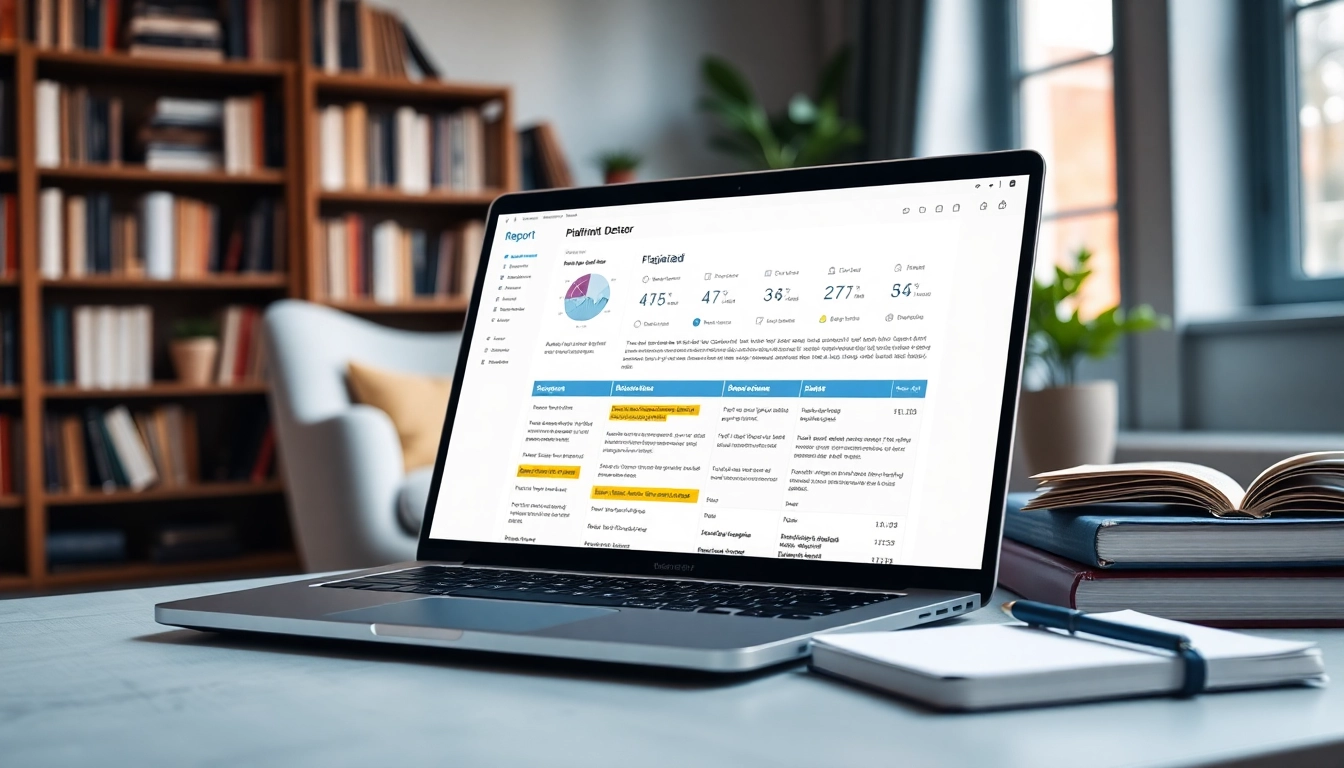Understanding Plagiarism Detectors
What is a Plagiarism Detector?
A plagiarism detector is a specialized software tool designed to identify text that has been copied or closely paraphrased from existing sources without appropriate citation. These tools are vital for maintaining academic integrity, as they help users, including students, teachers, and professionals, to ensure originality in their writing. A robust plagiarism detector offers a variety of functions, from simple text scanning to comprehensive reporting of similarities with other documents.
How Plagiarism Detection Works
Plagiarism detection software usually operates through sophisticated algorithms that scan the uploaded text against a database of documents, academic papers, online articles, and previously submitted works. The process typically involves the following steps:
- Text Analysis: The software breaks down the text into smaller components, analyzing syntax, phrasing, and word choice.
- Database Comparison: It compares these components against vast databases and the internet to find matching or similar sentences.
- Similarity Scoring: It generates a similarity score indicating the percentage of plagiarized content.
- Reporting: A comprehensive report is produced, detailing the sources of matched content and highlighting problematic areas.
Common Features to Look For
When choosing a plagiarism detector, users should consider several key features to ensure they select the most effective tool:
- Comprehensive Database: Effective tools should have access to a wide array of sources, including academic journals, web pages, and private databases.
- Real-Time Checking: Instant results are important for fast-paced environments like academia or content production.
- User-Friendly Interface: A straightforward interface allows users to quickly upload text and access reports without a steep learning curve.
- Detailed Reports: Quality tools provide thorough reports that not only indicate plagiarism but also provide context and suggestions for original phrasing.
- Integration Capabilities: Look for tools that can seamlessly integrate with existing writing platforms or learning management systems (LMS).
Importance of Using a Plagiarism Detector
Impact on Academic Integrity
Academic integrity is a cornerstone of educational systems worldwide. Plagiarism destroys the foundation of trust between students, educators, and institutions. Utilizing a plagiarism detector fosters honesty in scholarly work, encourages original research, and upholds the credibility of educational qualifications. Institutions that enforce strict anti-plagiarism policies benefit from higher standards and enhanced reputations.
Consequences of Unchecked Plagiarism
The repercussions of failing to check for plagiarism can be severe, including:
- Academic Penalties: Students may face failing grades, suspension, or expulsion.
- Legal Consequences: Authors can face copyright infringement lawsuits, leading to significant financial penalties.
- Damage to Reputation: For academics or professionals, plagiarism can result in loss of credibility and career advancement opportunities.
- Resource Wastage: Resources spent on work that lacks originality can lead to wasted time and money for both individuals and institutions.
How Detectors Benefit Writers
Writers benefit from plagiarism detectors in several ways:
- Improved Originality: Tools promote creative writing by encouraging original thought and providing suggestions to rephrase and paraphrase.
- Confidence in Submission: Knowing their work is free from unintentional plagiarism allows writers to submit confidently.
- Enhanced Learning: Understanding why certain texts or phrases may be flagged as plagiarized fosters better writing practices and citation knowledge.
Comparing Top Plagiarism Detectors
Evaluation Criteria for Detectors
To effectively compare plagiarism detectors, several evaluation criteria should be considered:
- Accuracy: The tool’s precision in identifying all forms of plagiarism, including hidden paraphrasing and self-plagiarism.
- Speed: The efficiency with which reports are generated after a document is submitted.
- Cost: The affordability of the service compared to the functionality provided; some services offer free basic checks, while others require subscriptions.
- Support and Resources: Availability of customer service and educational resources, like guides or FAQs.
Strengths and Weaknesses of Popular Tools
Here are some insights into a few of the most popular plagiarism detection tools:
| Tool | Strengths | Weaknesses |
|---|---|---|
| Grammarly | Integrates grammar checking and offers real-time plagiarism detection. | Subscription required for full access to plagiarism features. |
| Turnitin | Widely used in academic institutions with comprehensive databases. | Typically only available through institutional access or via subscriptions. |
| QuillBot | User-friendly interface with affordable pricing plans. | Limited database compared to larger services. |
| Duplication Checker | Completely free and easy-to-use. | May not provide detailed reporting or analysis. |
User Experience and Interface Comparison
A good user experience is essential for adoption, especially in academic settings. Some factors to consider include:
- Ease of Use: A simplistic layout reduces the learning curve, especially for students.
- Customization Options: Features that allow users to tailor settings can enhance the experience.
- Mobile Capability: With growing mobile usage, detectors that function well on smartphones and tablets are advantageous.
Best Practices for Plagiarism Detection
Steps to Effectively Use a Plagiarism Detector
To optimize the benefits of a plagiarism detector, users should follow these best practices:
- Choose the Right Tool: Evaluate options based on your specific needs, such as academic use, professional writing, or content creation.
- Prepare Your Text: Before submitting, ensure your document is in the proper format and free from errors that could affect the scan.
- Run Multiple Checks: Use different detectors, if possible, to ensure comprehensive coverage.
- Review Reports Carefully: Pay attention to suggested changes and flagged sections to understand and learn from the process.
Understanding Reports and Analytics
Once a scan is complete, users receive a report detailing the findings. This may include:
- Percentage of Similarity: Indicates how much of the text matches other sources.
- Source Listing: A detailed list of all matched sources for easy reference.
- Highlighting: Identified phrases or sentences will be shown for immediate review.
Integrating Detectors into Your Workflow
Having a plagiarism detection tool integrated into daily writing practices can significantly reduce the risk of unintentional plagiarism. Effective integration steps include:
- Regular Checks: Develop a habit of running content through a plagiarism detector before submitting any work.
- Collaborative Use: Encourage team or group projects to utilize a shared plagiarism detector, ensuring everyone is on the same page regarding originality.
- Training Sessions: Conduct training on using these tools effectively among peers or colleagues.
Future Trends in Plagiarism Detection Technology
AI and Machine Learning Integration
The future of plagiarism detection lies in the integration of AI and machine learning, which can improve accuracy and efficiency. These technologies allow for:
- Adaptive Learning: Systems that learn from past detections to identify new patterns in writing.
- Contextual Awareness: Understanding the context of content, thus identifying paraphrasing and subtle forms of plagiarism more accurately.
Emerging Features to Watch For
As technology advances, new features are expected in plagiarism detection tools:
- Real-Time Collaboration: Tools that enable multiple users to check texts concurrently.
- Enhanced Reporting: Advanced analytics that provide insights into writing trends, such as commonly used phrasing or citations.
- User-Specific Customizations: More options for tailoring results based on user needs, particularly in professional settings.
The Evolving Landscape of Academic Writing
As academic writing evolves, so too must our approaches to originality. With increased access to digital resources, the potential for plagiarism rises, making plagiarism detection more critical than ever. Future developments in this field aim to preserve the integrity of academic and professional writing while adapting to new technologies and challenges.



